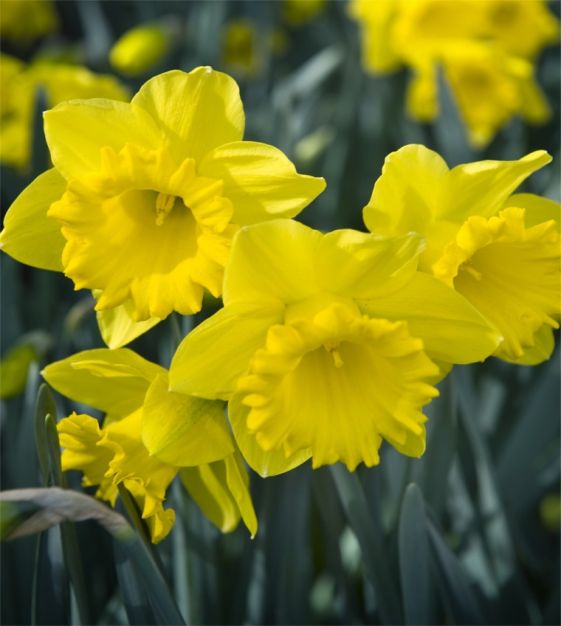-
- Discounted Collections
- 20%-Off Website Specials
- New for 2024!
- Tulips
- Narcissi
- Allium
- Anemone blanda
- Brodiaea
- Camassia
- Chionodoxa
- Corydalis
- Crocus
- Eranthis
- Eremurus
- Erythronium
- Fritillaria
- Galanthus
- Geranium
- Gladiolus
- Hyacinths
- Hyacinthoides
- Ipheion uniflorum
- Dutch Iris
- Rock Garden Iris
- Ixiolirion
- Leucojum aestivum
- Muscari
- Ornithogalum
- Oxalis
- Puschkinia
- Scilla
- Lilies
- Peonies
- Amaryllis
- Paperwhites
- Tender Bulbs
- Anemone Giants
- Tecolote Ranunculus
- Freesias
Landscape-Sized Narcissus Mando
(1 Y-Y) This sweetly scented, 1959 Guy Wilson hybrid has a 3 1/2”, star-shaped, brilliant yellow flower with a slightly darker funnel-shaped trumpet accented by a flared and frilled mouth. Narcissus Class: Trumpet or Long Cupped Daffodils (Royal Horticultural Society Division 1). Bulb size: SP 12/14 cm. April. HZ: 3-7. 15" to 18".
Narcissi are The Art & Soul of Spring.
Narcissus Horticultural Tips
Narcissi are The Art & Soul of Spring.
Narcissus Horticultural Tips
- Information
Trumpet Daffodils
The most well-known group of Narcissi, Trumpet Daffodils naturalize extremely well and have a long blooming season with large, bold flowers. To classify as a Trumpet, their flowers must have a trumpet (also known as the cup or the corona) as long as, or longer than, their petals (perianth). They yield one flower per stem. They are also much loved for the fact that deer and rodents do not like to eat them!
All Narcissi tolerate a wide range of sunlight from full sun to semi-shade. Varieties with pink cups should be grown in areas of filtered sunlight. Narcissi prefer well-draining soil, hate to get wet feet and love to be fed with a 4-10-6 or 5-10-5 granular organic flower bulb fertilizer three times a year. Allow the foliage to thrive and die back naturally without braiding or premature removal. DNII bulb size: 14/16 cm, unless otherwise noted. Bloom time in a horticultural zone 5: April. Plant 6" to 8" deep and 6" apart. Horticultural zones 3-7. Height: 18" to 20", depending upon variety. Narcissus classification: Royal Horticultural Society Division 1.
Narcissi are The Art & Soul of Spring.
Narcissus Horticultural Tips Narcissus Forcing Tips
The most well-known group of Narcissi, Trumpet Daffodils naturalize extremely well and have a long blooming season with large, bold flowers. To classify as a Trumpet, their flowers must have a trumpet (also known as the cup or the corona) as long as, or longer than, their petals (perianth). They yield one flower per stem. They are also much loved for the fact that deer and rodents do not like to eat them!
All Narcissi tolerate a wide range of sunlight from full sun to semi-shade. Varieties with pink cups should be grown in areas of filtered sunlight. Narcissi prefer well-draining soil, hate to get wet feet and love to be fed with a 4-10-6 or 5-10-5 granular organic flower bulb fertilizer three times a year. Allow the foliage to thrive and die back naturally without braiding or premature removal. DNII bulb size: 14/16 cm, unless otherwise noted. Bloom time in a horticultural zone 5: April. Plant 6" to 8" deep and 6" apart. Horticultural zones 3-7. Height: 18" to 20", depending upon variety. Narcissus classification: Royal Horticultural Society Division 1.
Narcissi are The Art & Soul of Spring.
Narcissus Horticultural Tips Narcissus Forcing Tips
Trumpet Daffodils
The most well-known group of Narcissi, Trumpet Daffodils naturalize extremely well and have a long blooming season with large, bold flowers. To classify as a Trumpet, their flowers must have a trumpet (also known as the cup or the corona) as long as, or longer than, their petals (perianth). They yield one flower per stem. They are also much loved for the fact that deer and rodents do not like to eat them!
All Narcissi tolerate a wide range of sunlight from full sun to semi-shade. Varieties with pink cups should be grown in areas of filtered sunlight. Narcissi prefer well-draining soil, hate to get wet feet and love to be fed with a 4-10-6 or 5-10-5 granular organic flower bulb fertilizer three times a year. Allow the foliage to thrive and die back naturally without braiding or premature removal. DNII bulb size: 14/16 cm, unless otherwise noted. Bloom time in a horticultural zone 5: April. Plant 6" to 8" deep and 6" apart. Horticultural zones 3-7. Height: 18" to 20", depending upon variety. Narcissus classification: Royal Horticultural Society Division 1.
Narcissi are The Art & Soul of Spring.
Narcissus Horticultural Tips Narcissus Forcing Tips
The most well-known group of Narcissi, Trumpet Daffodils naturalize extremely well and have a long blooming season with large, bold flowers. To classify as a Trumpet, their flowers must have a trumpet (also known as the cup or the corona) as long as, or longer than, their petals (perianth). They yield one flower per stem. They are also much loved for the fact that deer and rodents do not like to eat them!
All Narcissi tolerate a wide range of sunlight from full sun to semi-shade. Varieties with pink cups should be grown in areas of filtered sunlight. Narcissi prefer well-draining soil, hate to get wet feet and love to be fed with a 4-10-6 or 5-10-5 granular organic flower bulb fertilizer three times a year. Allow the foliage to thrive and die back naturally without braiding or premature removal. DNII bulb size: 14/16 cm, unless otherwise noted. Bloom time in a horticultural zone 5: April. Plant 6" to 8" deep and 6" apart. Horticultural zones 3-7. Height: 18" to 20", depending upon variety. Narcissus classification: Royal Horticultural Society Division 1.
Narcissi are The Art & Soul of Spring.
Narcissus Horticultural Tips Narcissus Forcing Tips





